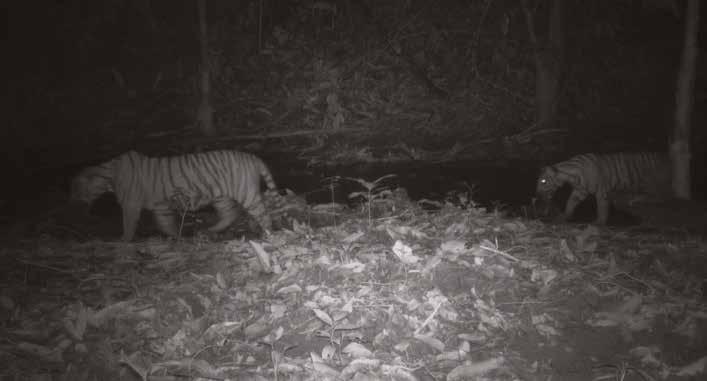
9 minute read
Feature story: The snaring crisis in Southeast Asia
Snares and traps used to illegally catch wildlife.
FEATURE STORY
Advertisement
THE SNARING CRISIS IN SOUTHEAST ASIA
Southeast Asia is home to some of the world’s rarest and most charismatic animals, but during the 20th century it suffered more global extinctions of mammals and birds than any other continental area. The primary threats? Habitat destruction and hunting; a larger proportion of which is done by snares. Driven by a demand for illegal wildlife trade products, these cheap and indiscriminate traps are silencing the forests. Urgent action needs to be taken to put an end to it.
© An Nguyen Nhat / WWF Luong Viet Hung, Protected Area Manager, WWF-Vietnam
©Shariff / WWF-Malaysia Dr. Mark Rayan Darmaraj, Lead of Wildlife Conservation Society's Malaysia Program When he started work with WWF-Viet Nam in 2010, Protected Area Manager Luong Viet Hung spent much of his time in the forest piloting a community-based forest guard model focused on removing snares in the Central Annamites Landscape. Every month, he accompanied the teams for 15 days at a time in the forest, where he faced snares in daunting numbers. Often Hung and his team would find snares set along fences (drift-fences) which hunters built to funnel all animal movement towards their lethal snares.

“The drift fence was hundreds or thousands of meters long. I was shocked and upset to see so many dead bodies of wildlife on the traps. The other members had the same reaction; their faces were saddened.”
After a moment of silence, the team knew what they had to do. “Without exchanging a single word we took action, destroying the drift fence, collecting the wires, and recording the field data on our datasheet. There were times we removed thousands of snares over a seven day patrol trip.”
From 2011 to 2019, the community-based forest guard model removed and destroyed over 100,000 snares in just two nature reserves. In the short-term removing snares likely prevents some deaths. “Can you imagine what would have happened if these snares had not been removed and destroyed? Would 100,000 animals have been trapped and killed?”
However snares often return and Hung points out the need for a more comprehensive approach to combat snaring. “Poaching is not an independent activity, it is a chain consisting of many links including local communities, protection agencies, traders, restaurants, markets and consumers. To end poaching, we need a comprehensive solution promoting sustainable livelihoods to local communities and changing the behaviors and awareness surrounding wildlife hunting. We need to use community engagement to strengthen protected area management and wildlife trade.”
Dr Mark Rayan Darmaraj has been working on tiger conservation with WWF for 16 years, and now leads Wildlife Conservation Society's Malaysia Program. In 2009, WWF patrol teams discovered a tiger within the Belum-Temengor Forest Complex. It had been caught in a snare, but was still alive. Mark reached the snare site by late evening, and parked up on the road just 600m from where the tiger lay. It's risky to attempt to release a trapped tiger at night in case the tiger escapes from the snare, so they waited until sunrise. They stood guard all night, waiting in case the poachers returned for the tiger. They did not.
At the break of dawn, the rescue operation sprung into action. Personnel from the Department of Wildlife and National Parks tranquilised the tiger, and heaved it on to a stretcher.
“I had the privilege of getting close to the animal before it was tranquilised, but I will never forget the roars of anguish and
© Lau Ching Fong / WWF-Malaysia

the fear in its still menacing eyes. As the paw was released from the snare I could see the deep wound it had inflicted. The bone was visible. To see the king of the jungle reduced to this vulnerable state of suffering invoked a sense of disgust and shock in me.”
A week or so later, Mark was informed that the tiger had died. He says he felt numb on hearing the news.
“It took me a while to uplift my battered soul and regain motivation, but eventually I did and I vowed to give my best to protecting tigers.” And Mark was not alone. In response to the crisis that caused the country’s tiger population to drop below 200 individuals, in 2018 local communities joined WWF to flood the forest to remove snares and deter poachers. It was an urgent, stop-gap initiative nicknamed “Project Stampede”.
“We now have 75 indigenous anti-poaching personnel helping us remove snares and deter poachers in Belum-Temengor Forest Complex and in 2020 only seven active snares were found.”
“My conversations with indigenous people have taught me that the forest is inextricably linked to their lives. They regard tigers to be the guardian of the forest, and although they hunt some small mammals, certain primates and birds for consumption, they value and respect all wildlife so this
A tiger is tranquilised for treatment after it is found caught in a wire snare in Malaysia’s Belum-Temengor Forest Complex, 2009
indiscriminate, cruel snaring is seen as a vicious way of wiping out wildlife.”
The community patrols are already playing a huge role in making the forests safe for tigers. Active snare encounters have reduced but Mark believes everyone has a role to play in stopping poachers using snares, from indigenous communities and enforcement agencies to government and key decision makers.
“Malaysia needs more enforcement personnel to guard the forest. Efforts to work with communities to be part of the solution need to be explored and expedited. And ultimately, political will to prioritise efforts in reducing this threat need to be invoked so that in years to come we will still have wildlife in our forest.”
WWF urges governments in Southeast Asia to strengthen enforcement and legislation to act as an effective deterrent against snaring, and engage indigenous peoples and local communities as partners to stop this threat. Protected areas need more and better resourced patrols. In addition to reducing urban demand for wildlife meat, governments must also prevent the purchase, sale, transport and consumption of wildlife species which are of high risk for zoonotic disease transmission. This will include most of the ungulates and carnivores that are major targets for snaring.
©Lau Ching Fong / WWF-Malaysia A Southern red muntjac discovered in Royal Belum State Park, Malaysia

©WWF-Malaysia Tigress and three cubs spotted on camera trap in Malaysia

MALAYSIA’S ANTI-POACHING TEAMS MAKING GAINS
WWF-Malaysia’s initiative Project Stampede was established in 2018 when there were only three patrol teams. As of 2020 there are now 15 patrol teams operating in Royal Belum State Park and Temengor Forest Reserve. Belum-Temengor Forest Complex in Malaysia is one of Southeast Asia’s most important tiger landscapes, yet it experienced a 50% decline in tiger numbers from 2009-2018 largely due to widespread snaring. However, since 2017 there has been a drastic increase in the number of patrol teams and a sharp decline in snares, which is good news for tigers and other wildlife in this region. covering 11,183km on foot, finding a total of just seven active snares and 31 old snares that were removed by the team. These are promising results.
MALAYSIAN GOVERNMENT COMMITS FUNDING
During the end of 2020 the Malaysian government announced it was allocating MYR20million (nearly USD5 million) under the 2021 National Budget for the Biodiversity Protection and Patrolling programme. Under this programme more than 500 retired army personnel and indigenous people will be employed to patrol protected areas, including tiger habitats. This increased patrolling presence has been strongly pushed for by WWF-Malaysia and will help to safeguard Malaysia’s remaining wildlife.
©Worrapan Phumanee / WWF-Thailand Students at Faculty of Forestry, Kasetsart University, Thailand

THREE LITTLE SIGNS OF HOPE IN MALAYSIA
Four tigers were captured on camera traps in Malaysia earlier this year. The camera traps revealed a female tiger walking through the forest followed closely by three cubs! BelumTemengor Forest Complex in Malaysia is one of Southeast Asia’s most important tiger landscapes. Since 2017 there has been a drastic increase in the number of patrol teams and a sharp decline in snares which is good news for tigers and other wildlife in this region.
HABITAT MONITORING IN BATANG HARI, CENTRAL SUMATRA
In Central Sumatra, in Indonesia WWF has been supporting the Forest Management Unit in Batang Hari Protected Forest by conducting SMART patrols and documenting illegal mining operations, illegal logging sites, land conversion activities, and newly illegally planted areas for palm oil, rubber, and bamboo. The information has been shared with relevant authorities and law enforcement agencies for improving better protection and management effectiveness. WWF-Indonesia is supporting authorities to reform existing poachers in Riau province.
SMART GETS SMARTER
This year in Cambodia the Protection Assistant for Wildlife Security software was fully integrated into SMART and is now being used by law enforcement in Srepok and Phnom Prich Wildlife Sanctuaries. This artificial intelligence has greatly helped protected area managers identify forest and wildlife crime hotspots. The software generates poaching risk maps and patrol routes which assist rangers by better informing their patrol strategies. Thanks to the technology rangers were successful in identifying 402 illegal logging and 251 illegal hunting cases.
THAILAND: EMPOWERING THE YOUNG GENERATION IN CONSERVATION
A “Smart Patrol for Protected Area Management” course was added to the curriculum for fourth-year students at the Faculty of Forestry at Kasetsart University. The programme is supported by the Department of National Parks, Wildlife and Plant Conservation, the Faculty of Forestry at Kasetsart University, Wildlife Conservation Society, and WWF.
Under this programme, annual SMART patrol training for students of the Faculty of Forestry at Kasetsart University has been taught since 2014. The WWF-Thailand Tiger Project is the host for this program and their staff train the students. The training will build the capacity of future Protected Area managers, for long term stewardship of wildlife and national resources in Thailand.
TRAINING WILDLIFE MONITORING UNITS IN MYANMAR
With the support of WWF-Myanmar, 29 community members were trained as part of a Wildlife Monitoring Unit and has begun occupancy surveys in remote areas of the Dawna Tenasserim Landscape. The data they collect as part of their surveys has been helping in building a picture of the status of tigers and prey in one of the most poorly understood tiger landscapes globally.
© Dongning Forestry Bureau / WWF











